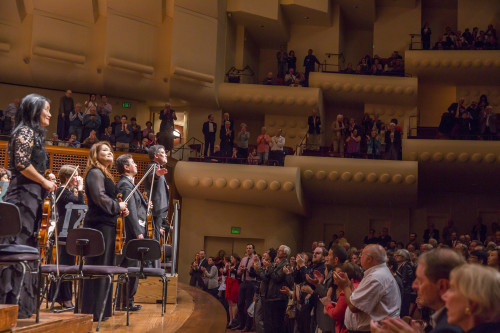 United States Beethoven, Sibelius: New York Philharmonic, Alan Gilbert (conductor), Davies Symphony Hall, San Francisco. 6.5.2016. (HS)
United States Beethoven, Sibelius: New York Philharmonic, Alan Gilbert (conductor), Davies Symphony Hall, San Francisco. 6.5.2016. (HS)
Beethoven: Egmont Overture; Symphony No. 7 in A major
Sibelius: Symphony No, 7 in C major; Finlandia

The New York Philharmonic muscled up for a rich and round opening concert in Davies Symphony Hall, the first of two evenings in San Francisco. The northern California stop is part of a 5-day tour that started in Costa Mesa earlier this week.
The Philharmonic’s music director, Alan Gilbert, who plans to step down from his New York post next year, put together a pair of seventh symphonies for this opener. He lavished marvelous insights on Sibelius but his knockabout Beethoven left some of us shaking our heads.
The orchestra sounded rich and meaty, the strings fat with orotund texture, the winds spicy and rambunctious. Perhaps it was a reflection of the imperfect acoustics in the orchestra’s home, David Geffen Hall, where the musicians must work extra hard to put a glow into their sound. The live expanses of Davies Hall seemed to magnify and distort such efforts. Although orchestral balances veered off course and passages lost a sense of precision in the Beethoven Seventh Symphony, the slow-moving, long-limbed climaxes of the Sibelius Seventh came off as majestic.
Gilbert simply seemed more at home in the open spaces of the Sibelius, underlining its sense of inexorable striving, arriving at one magnificent climax after another before settling into a serene landing. A sense of purpose and pulse infused the opening Adagio section. Every utterance of the trombone-led chorale, played against hurrying strings, grew more and more impassioned, thanks to Gilbert’s pacing and gorgeous work by principal trombone Joseph Alessi. The strings created a nervous restlessness underneath the faster passages and blossomed into dense clouds of sound in the work’s climax.
Gilbert’s years as conductor of the Stockholm Symphony from 2000 to 2008 clearly gave him an appreciation for the ins and outs of Scandinavian music. Along with a passion for 20th-century American works, it’s one of his strengths. He embraces Sibelius, the hero of Finland’s musical history, enough to make the final Finlandia several cuts above what’s usually heard in the concert hall. Gilbert held back just enough to lend gravitas to the opening sections and, by contrast, gave utter joy in the triumphant rush in the final pages, punctuated with more excellent work from the brass section.
In the Beethoven symphony, however, the balances that allowed these brass phrases to emerge seamlessly fell by the wayside. As hard as the violins tried to enrich their sound, every entrance by the brass simply overwhelmed. Instead of emerging from the general sound, the pair of French horns felt like they crashed through a wall in the work’s finale. Chordal punctuations by the brass and winds sounded more like solos rather than becoming part of the texture.
In the Allegro con brio finale, Gilbert’s rapid tempo choices didn’t help the string articulation, either. Too many rapid phrases turned to soup. The whole symphony just felt loud and coarse. The opener, the Egmont Overture, also felt excessive in volume, speeding like a runaway 18-wheeler instead of the finely-tuned race car it should be.
After all that sound and intensity, five curtain calls resulted in a gentle encore. Contrasting with the overt passion of the previous Sibelius, Gilbert led Valse Triste with transparency and wistful serenity.
Harvey Steiman

I believe you are too kind to Gilbert and the horns when you suggest the “loud and coarse” effects in Beethoven’s Egmont and 7th Symphony might have been attributable to the “live expanses of Davies Hall.” I heard them in the same program in the much less live Copley Symphony Hall in San Diego, where your adjectives “loud and coarse” exactly describe the horns in both Beethoven pieces. Every major horn entrance was a shockingly rude intrusion into what was otherwise wonderful playing by the rest of the orchestra (and I normally like aggressive horn-playing in these works). In 50 years of concert-going I have heard these pieces dozens of times by great, and not-so-great orchestras and conductors in many different acoustical environments. Never have I heard such horrible horn sounds in these pieces. It’s the job of any competent conductor to make appropriate adjustments to different halls. But I don’t think that was the problem here. I think that’s what Gilbert wanted, for whatever reason.